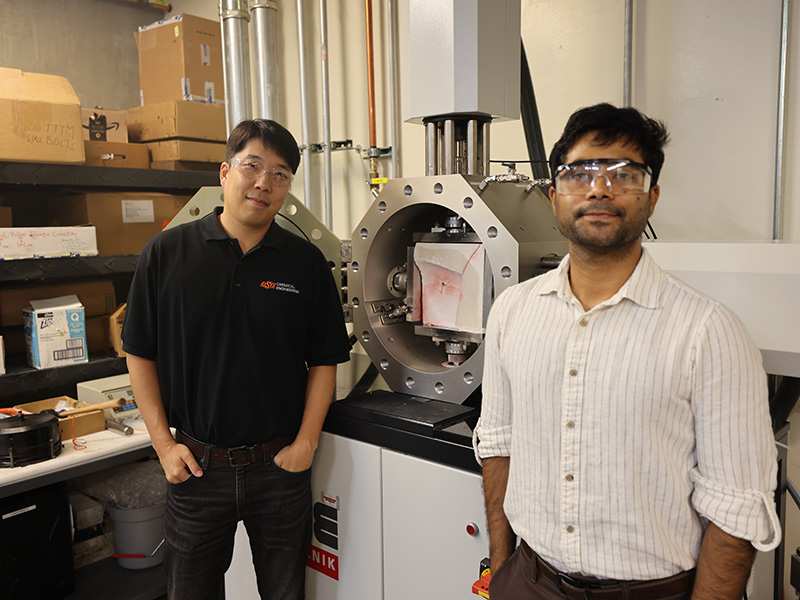
PETE researchers publish paper on how hydraulic fractures propagate and interact with discontinuities
Wednesday, October 29, 2025
Media Contact: Tanner Holubar | Communications Specialist | 405-744-2065 | tanner.holubar@okstate.edu
Petroleum engineering researchers in the College of Engineering, Architecture and Technology have advanced the understanding of how fracture propagation in naturally layered sedimentary rocks influences the development and spread of hydraulic fractures underground.
Dr. Hunjoo Lee, an assistant professor in petroleum engineering (PETE) in the School of Chemical Engineering, and Vishesh Bhadariya, a research assistant on Lee’s team, published a paper in Rock Mechanics and Rock Engineering titled, “Strain Field Analysis of Fracture Interaction with Bedding Planes and Implications for Height Growth in Layered Rocks.”
Their research investigated how bedding planes, or frictional layers in rock, influence the formation and spreading of hydraulic fractures during oil and gas extraction.
“These discontinuities often govern whether a fracture crosses, arrests or deflects — ultimately affecting fracture height and connectivity,” Bhadariya said. “We focused on understanding the mechanics at the fracture tip during interaction with bonded frictional interfaces to gain insight into fracture height growth in layered rock systems.”
The team used high-speed imaging and digital image correlation (DIC) during semi-circular bend tests to visualize how rock deforms and fractures near the crack tip. This experimental approach allowed them to quantify stress fields ahead of the fracture tip that enhance understanding of localized deformation mechanisms during fracture propagation through layered rock systems. Their preliminary research was presented at the 58th U.S. Rock Mechanics/Geomechanics Symposium in 2024, where it was selected as one of the top 10% of papers presented. It was then selected for publication in a special issue of RMRE.

Bhadariya said it took around a year to expand their research and develop a scientific novelty, which led to the latest publication of their research.
"It’s deeply rewarding to have our work recognized in ‘Rock Mechanics and Rock Engineering,’ one of the most respected journals in our field,” Bhadariya said. “This publication validates the scientific rigor and novelty of our near-tip strain analysis and demonstrates its relevance to the broader geomechanics community. It’s gratifying to see a concept evolve into a rigorous contribution that advances understanding and can guide future hydraulic fracture design.”
The team continues to learn more about fracture propagation under subsurface conditions using true-triaxial block tests that incorporate fluid injection, controlled stress anisotropy and frictional interface conditions to bridge the gap between the lab and the field.
Lee said he is proud to have seen Bhadariya’s hard work and dedication pay off with the publication of this article. It is a significant milestone early in his career, setting the foundation for his future contributions to the field.
"This accomplishment reflects his relentless effort in the laboratory, preparing samples, conducting experiments, and analyzing image data, as well as his dedication to revising the manuscript thoroughly,” Lee said. “I am also thankful to the reviewers for their insightful comments, which helped strengthen the final paper.”
